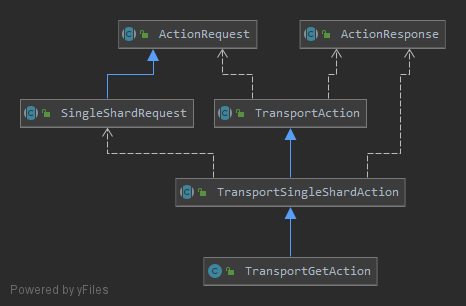1
2
3
4
5
6
7
8
9
10
11
12
13
14
15
16
17
18
19
20
21
22
23
24
25
26
27
28
29
30
31
32
33
34
35
36
37
38
39
40
41
42
43
44
45
46
47
48
49
50
51
52
53
54
55
56
57
58
59
60
61
62
63
64
65
66
67
68
69
70
71
72
73
74
75
76
77
78
79
80
81
82
83
84
85
86
87
88
89
90
91
92
93
94
95
96
97
98
99
100
101
102
103
104
105
106
107
108
109
110
111
112
113
114
115
116
117
118
119
120
121
122
123
124
125
126
127
128
129
130
131
132
133
134
135
136
137
138
139
140
141
142
143
144
145
146
147
148
| private GetResult innerGet(String id, String[] gFields, boolean realtime, long version, VersionType versionType,
long ifSeqNo, long ifPrimaryTerm, FetchSourceContext fetchSourceContext) {
fetchSourceContext = normalizeFetchSourceContent(fetchSourceContext, gFields);
// 调用Engine获取数据
Engine.GetResult get = indexShard.get(new Engine.Get(realtime, realtime, id)
.version(version).versionType(versionType).setIfSeqNo(ifSeqNo).setIfPrimaryTerm(ifPrimaryTerm));
assert get.isFromTranslog() == false || realtime : "should only read from translog if realtime enabled";
if (get.exists() == false) {
get.close();
}
if (get == null || get.exists() == false) {
return new GetResult(shardId.getIndexName(), id, UNASSIGNED_SEQ_NO, UNASSIGNED_PRIMARY_TERM, -1, false, null, null, null);
}
try {
// 获取返回结果
// break between having loaded it from translog (so we only have _source), and having a document to load
return innerGetLoadFromStoredFields(id, gFields, fetchSourceContext, get, mapperService);
} finally {
get.close();
}
}
//对指定的field、source进行过滤(source过滤只支持对字段),
//把结果存于GetResult对象中
private GetResult innerGetLoadFromStoredFields(String id, String[] storedFields, FetchSourceContext fetchSourceContext,
Engine.GetResult get, MapperService mapperService) {
assert get.exists() : "method should only be called if document could be retrieved";
// check first if stored fields to be loaded don't contain an object field
DocumentMapper docMapper = mapperService.documentMapper();
if (storedFields != null) {
for (String field : storedFields) {
Mapper fieldMapper = docMapper.mappers().getMapper(field);
if (fieldMapper == null) {
if (docMapper.mappers().objectMappers().get(field) != null) {
// Only fail if we know it is a object field, missing paths / fields shouldn't fail.
throw new IllegalArgumentException("field [" + field + "] isn't a leaf field");
}
}
}
}
Map<String, DocumentField> documentFields = null;
Map<String, DocumentField> metadataFields = null;
BytesReference source = null;
DocIdAndVersion docIdAndVersion = get.docIdAndVersion();
// force fetching source if we read from translog and need to recreate stored fields
boolean forceSourceForComputingTranslogStoredFields = get.isFromTranslog() && storedFields != null &&
Stream.of(storedFields).anyMatch(f -> TranslogLeafReader.ALL_FIELD_NAMES.contains(f) == false);
FieldsVisitor fieldVisitor = buildFieldsVisitors(storedFields,
forceSourceForComputingTranslogStoredFields ? FetchSourceContext.FETCH_SOURCE : fetchSourceContext);
if (fieldVisitor != null) {
try {
docIdAndVersion.reader.document(docIdAndVersion.docId, fieldVisitor);
} catch (IOException e) {
throw new ElasticsearchException("Failed to get id [" + id + "]", e);
}
source = fieldVisitor.source();
// in case we read from translog, some extra steps are needed to make _source consistent and to load stored fields
if (get.isFromTranslog()) {
// Fast path: if only asked for the source or stored fields that have been already provided by TranslogLeafReader,
// just make source consistent by reapplying source filters from mapping (possibly also nulling the source)
if (forceSourceForComputingTranslogStoredFields == false) {
try {
source = indexShard.mapperService().documentMapper().sourceMapper().applyFilters(source, null);
} catch (IOException e) {
throw new ElasticsearchException("Failed to reapply filters for [" + id + "] after reading from translog", e);
}
} else {
// Slow path: recreate stored fields from original source
assert source != null : "original source in translog must exist";
SourceToParse sourceToParse = new SourceToParse(shardId.getIndexName(), id, source, XContentHelper.xContentType(source),
fieldVisitor.routing());
ParsedDocument doc = indexShard.mapperService().documentMapper().parse(sourceToParse);
assert doc.dynamicMappingsUpdate() == null : "mapping updates should not be required on already-indexed doc";
// update special fields
doc.updateSeqID(docIdAndVersion.seqNo, docIdAndVersion.primaryTerm);
doc.version().setLongValue(docIdAndVersion.version);
// retrieve stored fields from parsed doc
fieldVisitor = buildFieldsVisitors(storedFields, fetchSourceContext);
for (IndexableField indexableField : doc.rootDoc().getFields()) {
IndexableFieldType fieldType = indexableField.fieldType();
if (fieldType.stored()) {
FieldInfo fieldInfo = new FieldInfo(indexableField.name(), 0, false, false, false, IndexOptions.NONE,
DocValuesType.NONE, -1, Collections.emptyMap(), 0, 0, 0, false);
StoredFieldVisitor.Status status = fieldVisitor.needsField(fieldInfo);
if (status == StoredFieldVisitor.Status.YES) {
if (indexableField.numericValue() != null) {
fieldVisitor.objectField(fieldInfo, indexableField.numericValue());
} else if (indexableField.binaryValue() != null) {
fieldVisitor.binaryField(fieldInfo, indexableField.binaryValue());
} else if (indexableField.stringValue() != null) {
fieldVisitor.objectField(fieldInfo, indexableField.stringValue());
}
} else if (status == StoredFieldVisitor.Status.STOP) {
break;
}
}
}
// retrieve source (with possible transformations, e.g. source filters
source = fieldVisitor.source();
}
}
// put stored fields into result objects
if (!fieldVisitor.fields().isEmpty()) {
fieldVisitor.postProcess(mapperService::fieldType);
documentFields = new HashMap<>();
metadataFields = new HashMap<>();
for (Map.Entry<String, List<Object>> entry : fieldVisitor.fields().entrySet()) {
if (mapperService.isMetadataField(entry.getKey())) {
metadataFields.put(entry.getKey(), new DocumentField(entry.getKey(), entry.getValue()));
} else {
documentFields.put(entry.getKey(), new DocumentField(entry.getKey(), entry.getValue()));
}
}
}
}
if (source != null) {
// apply request-level source filtering
if (fetchSourceContext.fetchSource() == false) {
source = null;
} else if (fetchSourceContext.includes().length > 0 || fetchSourceContext.excludes().length > 0) {
Map<String, Object> sourceAsMap;
// TODO: The source might be parsed and available in the sourceLookup but that one uses unordered maps so different.
// Do we care?
Tuple<XContentType, Map<String, Object>> typeMapTuple = XContentHelper.convertToMap(source, true);
XContentType sourceContentType = typeMapTuple.v1();
sourceAsMap = typeMapTuple.v2();
sourceAsMap = XContentMapValues.filter(sourceAsMap, fetchSourceContext.includes(), fetchSourceContext.excludes());
try {
source = BytesReference.bytes(XContentFactory.contentBuilder(sourceContentType).map(sourceAsMap));
} catch (IOException e) {
throw new ElasticsearchException("Failed to get id [" + id + "] with includes/excludes set", e);
}
}
}
return new GetResult(shardId.getIndexName(), id, get.docIdAndVersion().seqNo, get.docIdAndVersion().primaryTerm,
get.version(), get.exists(), source, documentFields, metadataFields);
}
|


